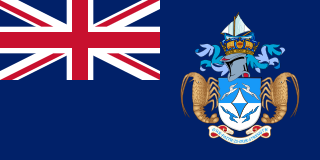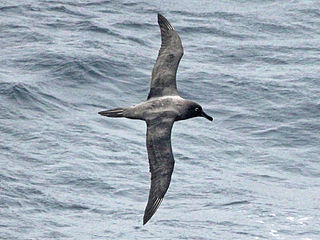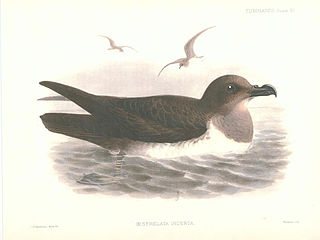
Tristan da Cunha, colloquially Tristan, is a remote group of volcanic islands in the south Atlantic Ocean. It is the most remote inhabited archipelago in the world, lying approximately 1,732 miles (2,787 km) off the coast of Cape Town in South Africa, 1,514 miles (2,437 km) from Saint Helena and 2,487 miles (4,002 km) off the coast of the Falkland Islands.

The subantarctic fur seal is found in the southern parts of the Indian, Pacific, and Atlantic Oceans. It was first described by Gray in 1872 from a specimen recovered in northern Australia—hence the inappropriate specific name tropicalis.

The southern giant petrel, also known as the Antarctic giant petrel, giant fulmar, stinker, and stinkpot, is a large seabird of the southern oceans. Its distribution overlaps broadly with the similar northern giant petrel, though it overall is centered slightly further south. Adults of the two species can be distinguished by the colour of their bill-tip: greenish in the southern and reddish in the northern.

The sooty albatross, dark-mantled sooty albatross or dark-mantled albatross,, is a species of bird in the albatross family. They breed on sub-Antarctic islands and range at sea across the Southern Ocean from South America to Australia.

The Atlantic yellow-nosed albatross is a large seabird in the albatross family. The scientific name is from Ancient Greek. Thalassarche is from thalassa, "sea" and arkhe, "command", and chlororhynchos is from khloros, "yellow", and rhunkhos, "bill".

The blue petrel is a small seabird in the shearwater and petrel family, Procellariidae. This small petrel is the only member of the genus Halobaena, but is closely allied to the prions. It is distributed across the Southern Ocean but breeds at only six known sites, all close to the Antarctic Convergence zone.

The Tristan albatross is a large seabird from the albatross family. One of the great albatrosses of the genus Diomedea, it was only widely recognised as a full species in 1998.

The Kerguelen petrel is a small slate-grey seabird in the family Procellariidae. The species has been described as a "taxonomic oddball", being placed for a long time in Pterodroma before being split out in 1942 into its own genus Aphrodroma. The position within the procellariids is still a matter of debate; when it was split away from the Pterodroma petrels it was suggested that it may be a fulmarine petrel, whereas a 1998 study placed the species close to the shearwaters and the genus Bulweria.

The Atlantic petrel is a gadfly petrel endemic to the South Atlantic Ocean. It breeds in enormous colonies on Tristan da Cunha and Gough Island, and ranges at sea from Brazil to Namibia, with most records at sea being to the west of the breeding islands, and along the subtropical convergence.

The Gough moorhen is a medium-sized, almost flightless bird that is similar to the common moorhen, but is smaller, stockier, and has shorter wings. The bird has a distinctive yellow-tipped red bill and red frontal shield. Its first account was written in 1888 by the polar explorer George Comer, whom the specific name comeri commemorates. This bird is found only on two remote islands in the South Atlantic.

The Tristan moorhen is an extinct species of flightless rail endemic to the South Atlantic island of Tristan da Cunha. It was very similar to the Gough moorhen of Gough Island, located 395 miles to the southeast.

The Antarctic tern is a seabird in the family Laridae. It ranges throughout the southern oceans and is found on small islands around Antarctica as well as on the shores of the mainland. Its diet consists primarily of small fish and crustaceans. It is very similar in appearance to the closely related Arctic tern, but it is stockier, and it is in its breeding plumage in the southern summer, when the Arctic tern has shed old feathers to get its non-breeding plumage. The Antarctic tern does not migrate like the Arctic tern does, but it can still be found on a very large range. This tern species is actually more closely related to the South American tern.
Agrostis goughensis is a species of grass in the family Poaceae. It is found on Gough Island.
Deschampsia robusta is a species of grass in the family Poaceae. It is found on Gough Island, near Tristan da Cunha.

The grey petrel, also called the brown petrel, pediunker or grey shearwater is a species of seabird in the Procellariidae, or petrel family. It occurs in the open seas of the Southern Hemisphere, mainly between 58°S and 32°S.

The soft-plumaged petrel is a species of seabird in the family Procellariidae.

The Gough finch or Gough bunting, is a critically endangered species of songbird.
Rostkovia is a genus of plant in family Juncaceae described as a genus in 1809.
Scirpus bicolor is a species of plant in the sedge family, Cyperaceae. The plant is endemic to Tristan da Cunha, Nightingale Island, Inaccessible Island and Gough Island. Its natural habitats are subantarctic forests, subantarctic shrubland, and swamps.

The northern rockhopper penguin, Moseley's rockhopper penguin, or Moseley's penguin is a penguin species native to the southern Indian and Atlantic Oceans. It is described as distinct from the southern rockhopper penguin.
















